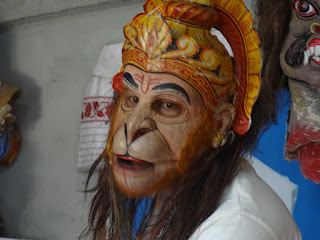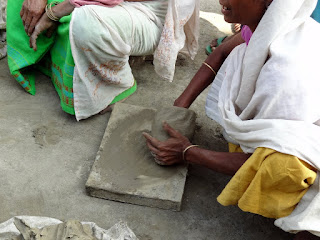Visits to Majuli and the Kaziranga Wildlife Sanctuary in Assam.
We made an early start from Jorhat one morning to be at the ferry terminal by 8 - still misty and foggy and cold - to cross India's biggest, and only male, river, the Brahmaputra to Majuli. Coming from a very dry state (South Australia) the size of the river is incredibly immense, and seeing the further expanse covered with water during flood times is unbelievable.
The ferry wasn't quite like any car ferry I'd been on before...
and the loading 'terminals' were a confusion of buses, trucks, cars and
motorbikes, some arriving and some departing. It took 6 cars (ours were
booked on) about 40 motor bikes and 100+ passengers. The smooth passage
took an hour.
and the cars were secured with a piece of rock or brick...
the red is from tail lights as it was dark when we returned at 5pm. This was the amazing sunset - a huge red ball (not the greatest picture from my simple camera)
Other smaller ferries carried people and goods - like this wardrobe which was walked off, followed by a dressing table.
Said to be the largest river island in the world, Majuli has been considered the cultural capital of Assam for many years. Now it is like a last bastion for traditions and culture. The houses are mostly built on stilts, and much of the island faces flooding each year.
We visited traditional mask makers.
The base is made from bamboo, covered with clay, and then dung, before painting and decorating, as shown from left to right in this picture
One of the makers gave some clever, impromptu performances . The characters are traditional from stories and dances.
We visited a monastery where we were offered chai. As happened in a few places it came in plastic cups !!! On this occasion mine actually collapsed with the heat and has a hole on the back side.
This young lad had just joined the monastery the day before. They can enter from as young as four.
The buildings were simple with not a lot of decoration
I liked these drums hanging on the wall
From there we visited some potters. They make the pots by paddling the clay, with no wheels, and then fire them over 24 hours on mounds over a fireplace which has a central vent. The process is slow compared to modern methods, but they were amazingly fast when I think of my handbuilding attempts. Different women do different stages, and they virtually made a pot while we were watching. You can see the day's work beside them.
The first lady takes a lump of clay and works her hand into the centre
The second adds coils or bands to increase the height, and the third, paddles the shape smooth.
The fire place underneath
The mound the pots will be laid on. Straw is laid, then the pots and more straw and a layer of clay.
The pots covered with clay and the fire is lit
The gray pots fire to an orange colour.
The visit to the wildlife sanctuarycomes with a list of 'might sees' - elephant, tiger, water buffalo, one horned rhinocerus and many birds. We travelled in open jeeps with spotters and a chap armed with a rifle (presumably to deal with/scare off situations like the day before when a rhino chased a jeep!) We didn't see any tigers, but were lucky enough to see 2 elephants, lots of water buffalo and about 10 rhinos, plus some basking otters and a lot of birds including green pigeons, rollers (the one with the blue pictured), cranes, eagles and storks...
There is a second elephant, a young one on the right of this photo. Fortunately we spotted these in just the last few minutes of our visit.






























































